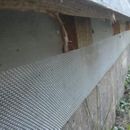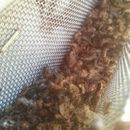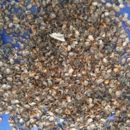Rainscreen full of bugs
I’ve got a building with horizontal cedar siding over 1″ furring strips. The vent space at the bottom of the wall is protected by stainless screening to keep the critters out. Unfortunately, it also seems to keep them in. It’s ladybugs mostly. It’s impossible to keep them out, and they either freeze to death in the winter, or can’t escape. If the mesh size had been larger, they could be vacuumed out, although wasps would gain entry and may clog the space with nests.
Pulling the mesh out and replacing it would be difficult, as it is nailed to the wall behind the furring strips.
My not so good options are to take the lower course of siding off every several years for a clean out, puncture the mesh with an appropriately sized awl to allow insect exit/entry or just accept that the walls are slowly going to fill with exoskeletons.
Would appreciate any ideas.
GBA Detail Library
A collection of one thousand construction details organized by climate and house part












Replies
Richard,
My first reaction is, "Is this really a problem?" Those exoskeletons look dry and harmless.
My second reaction is, "Where is the opening through which these insects enter?" If they can't get through the screening, it's probable that the insects are entering through cracks between courses of your siding.
My siding isn't ladybug tight, not even close. Once they find an entry they use chemical trail markers to notify the others. Being dry they are benign, but I can imagine how many there will be in a few decades. It could get gross if the siding is ever compromised. If memory serves correct a ventilated rainscreen is overkill for my area, so not a big deal if the mesh is clogged. That said, it could be a lesson for someone else deciding on a mesh size.
Cheers,
Richard
Richard,
Did you ever solve this problem? I am in the final stages of a renovation where I have removed and replaced all insulation and sheathing and added 2 inches of rigid foam, and this detail has me stymied. I am concerned that bugs will find their way in between siding courses in the lap siding and will accumulate at the base of the rainscreen.
The reason I started the whole project was because the Northern Flicker (woodpeckers) were destroying my siding annually to get to the critters behind the siding, and it didn't even have a rainscreen!
You could put a layer of fiberglass window screen up over the furring strips before hanging the siding. Think of this as a “bugwrap” and BRP (bug resistant barrier), and detail it similarly to how you detail housewrap or a WRB, although it’s not as critical as a WRB. All you need is a tight barrier that can breath but that will limit bug entry.
Bill
I will be in the middle of this soon at my house replacing one entire 30'x30' side. Currently my 1x8 Channel Rustic Cedar siding is diagonal to follow the roof line on this side of the house. We hate it and I will be making it horizontal for sure. Also its all destroyed from the sun/weather/bugs/woodpeckers. It is original (31 years old) and the previous owner had it solid stained probably once. There is no rainscreen or bug/mouse screen either and I dont even think there are furring strips (All things I will be implementing)
I like the idea of the window screen from the post above. The window screening 'could' get compromised though with mice im sure, right? Or do you propose this window screen in addition to a rodent/bug type screen?
I would use stainless steel (NOT aluminum) screen at the bottom of the rainscreen to keep out critters. Another screen at the top too is a good idea if you have both top and bottom venting.
The fiberglass screening would go over the furring just before the siding, so this screen would go up similar to how housewrap goes up. It would just be there to try to limit bugs getting through small gaps between panels or boards of the siding. I would expect mice or any larger critters to be a problem here since the siding itself should keep those critters out.
Bill
@Zephyr7 "Another screen at the top too is a good idea if you have both top and bottom venting."
Bill, are you saying that a vent at the top of the rainscreen for the siding is not necessary? If so, this would be a huge help to our situation. Struggling with the details for false/applied eaves and incorporating the top vent.
Dustin,
On a percentage basis the vast majority of rain-screened walls do not have a top vent. These walls work well and include most of the attributes that rain-screens need to help the assemblies dry. Do top vented rain-screens work better? Yes, but I'm not sure the improvement is sufficient to say top-venting is a necessary part of a rain-screen wall.
One caveat is that my reply may be climate dependant. Some builders in New England report seeming condensation at the top of rain-screened walls in very cold weather. Something I've never heard of in milder wet climates like the PNW.
Some kind of small rodent has been chewing holes in my fiberglass screen and then hollowing out the EPS foam behind the rainscreen to make a cozy nest. So I second the recommendation for a stainless screen.
That sounds like a mouse. Sometimes you can get them to leave by stuffing steel wool into their nest and access holes/tunnels. They don’t like chewing on and burrowing in steel wool.
Bill
The same trajectory occurred using insect screen for soffit venting starting in the 60s. At first it seemed like a simple, quick solution, and it's fragility was said not to matter because it was being used in a place where it was hard to damage. But over time it was shown to be an inappropriate material, too easily broached, and very difficult to repair once damaged.
Insect screen is now usually reserved for places where it can be easily replaced, and secured with rubber gaskets to facilitate that. The only way I'd consider using it to block vented cavities is if it could be detailed in a similar way for easy replacement.
Bugs will always get behind siding. No matter what you do, they will find a way.
You just have to make sure that you keep the larger bugs such as wasps and bees out. Mesh, corovent and ridge vent material will do a great job at this. The rest of the bugs and ladybug carcasses won't do any damage.
The combination of cost and availability for Cor-a-vent (not a single store in Colorado appears to stock it) has made me look for alternatives. I appreciate the comments about insect screen failures from rodents. The original articles on the site and many of the videos available still suggest screen, so I thought it would still be a suitable alternative. Does anyone have a good source for non-fiberglass "mesh" that may work as a substitute to fill the 3/4 inch gap at top and bottom?
My project is a bit shoestring, and spending $800 on a bug filter wasn't in the plans. There has to be a way to go green for average income folks if we want to have the green building transition to the public at large, I hope!
My go to source for wire mesh is TWP Inc. They have many mesh sizes and gauges in different materials. I would use 304 or 316 stainless steel welded mesh. 316 has the best corrosion resistance, but I costs a bit more than 304. 304 still has pretty good corrosion resistance but is a little cheaper.
Don’t use aluminum mesh. Aluminum is prone to rotting away. Copper holds up well, but tends to cause galvanic issues with other metal fasteners. Stainless steel is the most stable of the common metals used to make wire mesh.
Bill
DIGIIKM,
Block the bottom of the foam with lumber, and cover the rain-screen gap with perforated metal flashing. It comes in at under a buck a linear foot.
For example: https://www.menzies-metal.com/metal-flashings/perforated-j-channel-rain-screen-low-back/
Trim always costs money. For a clean finish, the bottom of the foam will need trim anyways, a piece of custom bent up perforated J trim is not that much.
If you want to DIY-it, you can rent a metal brake and grab some perforated soffit covers as stock. You can use the brake to bend up the rest of the metal you'll need for the house as well at the same time.
Not as clean, but you can also grab some of this: https://www.gaf.ca/roofing/residential/products/roof_vents/cobra_exhaust_vent
Stock item at my local box store and roofing supply. Cut it into 1.5" strips and tack it between the rain screen battens.
They aren't lady bugs, but rather a type Asian beetle that is invasive. They love moisture, so if your rain barrier attracts them, I would wonder how well it was working. They love to beat together is moist fiberglass from my experience tearing my "new" house apart. Caulking gaps and aggressive sawzall blades were the downfall for me where I have seen the worst cases. Seems like a removable section of wire at the bottom hanging a little lower would alert you to filling and allow for cleanup.